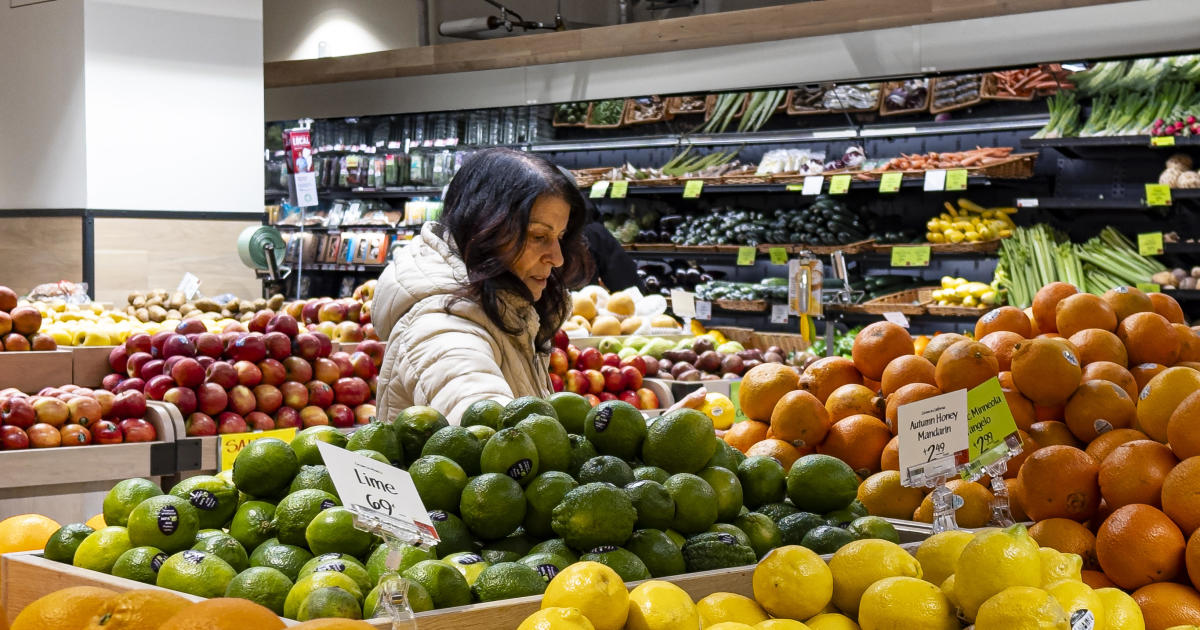CBS News
New WIC rules include more money for fruits and vegetables for low-income families

The federal program that helps pay for groceries for millions of low-income mothers, babies and young kids will soon emphasize more fruits, vegetables and whole grains, as well as provide a wider choice of foods from different cultures.
The final rule changes for the program known as WIC were announced Tuesday by the Food and Nutrition Service, and will take effect within two years with some exceptions.
Last updated a decade ago, the new WIC rules make permanent a bump in monthly cash vouchers for fruits and vegetables — something first enacted during the COVID-19 pandemic. Shoppers can also add canned fish, fresh herbs and lactose-free milk to their carts, among other changes. The voucher piece will take effect by June, officials said.
“It places a heavy emphasis on fruits and vegetables, which we think is an important component of a healthy diet,” Agriculture Secretary Tom Vilsack said in an interview. “It’s designed to fill the nutrition gaps that are often in the diets of many of us.”
The WIC program served an average of about 6.6 million low-income Americans a month in 2023 at a cost of a little more than $7 billion. It’s designed to supplement the food budgets for pregnant, nursing and postpartum women, as well as to feed babies and young kids up to age 5. That’s done by providing vouchers to mothers and children who qualify and specifically listing the amount and types of food they can buy.
But officials have said only about half of those eligible are enrolled in the Supplemental Nutrition Program for Women, Infants and Children.
Peter K. Afriyie / AP
Under the new rules, fruits and vegetable vouchers in 2024 will provide $26 per month for kids ages 1 through 4; $47 per month for pregnant and postpartum women; and $52 for breastfeeding women. The changes also expand access to whole grains like quinoa, wild rice and millet and to foods such as teff and whole wheat naan. They also remove or reduce monthly allowances for juice and cut back on allowances for milk.
Food plans in the program are based on recommendations from the National Academies of Science, Engineering and Medicine and the federal 2020-2025 Dietary Guidelines for Americans.
The plan failed to include a change requested by top allergists in the U.S. that would have added peanut products to foods allowed for babies ages 6 months to 11 months to help prevent peanut allergies.
Research published in 2015 showed early introduction to peanut foods can reduce the chance of allergy development in kids who are at high risk, and several U.S. guidelines suggest exposing high-risk children to peanuts as early as 4 months.
Adding peanut to the WIC guidelines may have prevented more than 34,000 infants from developing a peanut allergy, said Dr. Gideon Lack of King’s College London, who led the study. But federal nutrition officials concluded that the change was “outside the scope” of the final rule.
Dr. Ruchi Gupta, a pediatrics professor and child allergy expert at Northwestern University, called the omission “disappointing.” She noted that WIC enrollees often include children of color who are at higher risk of developing dangerous peanut allergies.
The decision “can only increase disparities we are already seeing in food allergy prevalence,” she said.
CBS News
Eye Opener: Biden says he will stay in race

Watch CBS News
Be the first to know
Get browser notifications for breaking news, live events, and exclusive reporting.
CBS News
2 Mississippi inmates awaiting murder trials escape from prison

Law enforcement officers were searching Friday for two inmates who escaped from a jail in southwestern Mississippi.
The two men are awaiting trial on murder charges in separate counties.
Tyrekennel Collins, 24, and Dezarrious Johnson, 18, broke out of the Claiborne County Detention Center at about 2:20 a.m. Friday, the Claiborne County Sheriff’s Department said in a social media post.
The jail is in Port Gibson, about 60 miles (96.6 kilometers) southwest of Jackson.
Camera footage showed Collins and Johnson escaping through the ceiling and leaving behind an outside wall, Claiborne County Sheriff Edward Goods told WAPT-TV. Johnson injured one of his legs during the escape and was walking with a limp, the sheriff’s department said.
The Mississippi Bureau of Investigation said Collins and Johnson are considered armed and dangerous.
WJTV-TV reported Collins is charged with murder in the October killing of his cousin in Copiah County, which is about 40 miles (64.4 kilometers) west of Claiborne County. Court records on Friday did not show an indictment for Collins.
Johnson is charged with murder and aggravated assault in Jefferson County, which is just south of Claiborne County. Court records show he was indicted in the October 2022 killing of one person and injuries to two others. His trial is set to begin Oct. 15.
CBS News
As sunscreen misinformation spreads online, dermatologists face real-life impact of online trends

With the holiday weekend in full swing, the anti-sunscreen movement’s recent spike is worrying dermatologists.
“It was not like this before,” Dr. Jeanine Downie, a board-certified dermatologist with her own practice in New Jersey told CBS News Confirmed. “I see easily six patients per week that are anti-sunscreen, where it used to be maybe one every other week or one a month. And now it’s just gotten crazy.”
Downie says in the last two weeks she’s diagnosed three squamous cell and two malignant melanomas, both of which can turn cancerous if not caught early. “And that’s me, just one little dermatologist,” she said.
This movement picked up steam in June, with creators on TikTok telling followers in no uncertain terms “stop wearing sunscreen.” At first, the posts received tens of thousands of views and likes. Dermatologists on the platform then began sharing their own reactions, with those videos gaining even more views. And more recently, influencer Nara Smith went viral sharing an at-home sunscreen recipe to her 8 million followers that dermatologists say does little to protect wearers from sun damage.
Dr. Shereene Idriss, a New York dermatologist who has amassed more than a million followers on her social media channels, is trying to leverage that influence to educate users about sunscreen and sun protection.
“It’s becoming more and more difficult, I think, as a consumer, to try to weed through the noise,” Idriss told CBS News Confirmed.
This misinformation reflects the surprising reality of how some young Americans view sun safety. A study by the Orlando Health Cancer Institute in March found that 1 in 7 adults under the age of 35 say daily sunscreen use is more harmful than direct sun exposure. “I tell my patients, if you want your face to look like a leather bag later, then that’s up to you,” Downie said. About 6.1 million adults are treated each year for basal cell and squamous cell carcinomas according to the CDC. Skin cancer is the most common type of cancer in the country.
“They only want the natural things,” said Downie. “But I tell them all the time, sitting in traffic here in the tri-state area, the level of pollutants in the air on a daily, weekly and monthly basis is significantly more toxic than any chemical they’re going to rub into their skin with sunblock.”
While there’s no evidence that sunscreens are unsafe, the FDA is currently investigating potential concerns. It’s called for more data on 12 ingredients often found in U.S. sunscreen. After conducting its own study into how certain ingredients are absorbed into the bloodstream, the FDA has called for more research into potential health effects on the body.
However, beachgoers on the Jersey Shore this week told CBS News that sun safety is top of mind this summer. CBS News Confirmed looked at Google Search trends and saw terms like “sunscreen” and “what does skin cancer look like” are at an all-time high since tracking began in 2004.
“You know what gets them to start wearing sunblock?” said Downie. “Young kids and young adults, Gen Z, Gen X, they hate pores. And once they hear that they’re going to have big pores that look like potholes, they put that sunblock on.”
The dermatologists CBS Newsspoke with say there is no such thing as a healthy tan. To best protect yourself this summer, they say to use sunscreen and reapply often; wear UPF clothing or UV visors; and avoid being outside during peak UV index between 10 a.m. and 2 p.m.








